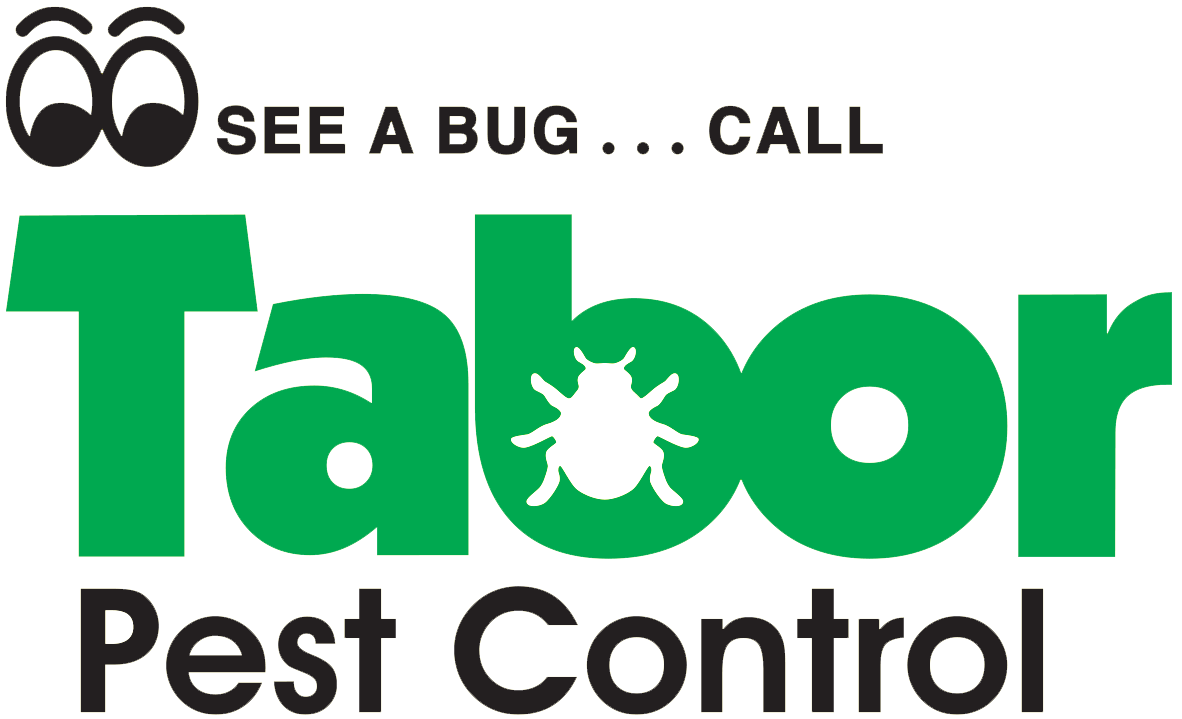Posts Tagged ‘Termites’
Wood Treatment for Termites: Comprehensive Protection for Your Home
Posted on: November 29th, 2023 No CommentsTermites are one of the most formidable enemies of home structures, capable of causing extensive and costly damage before they are even detected. Tabor Pest Control, with years of experience in combating termites, is here to guide you through this process.
By taking proactive measures and using proper wood treatments, you can significantly reduce the risk of termite infestations and safeguard your property.
Understanding Termites: The Silent Threat
Identifying and understanding the behavior of termites is the first step in effective prevention and treatment.
These pests come in various types, each with its unique characteristics and behaviors:
- Subterranean Termites: The most common in the U.S., they build mud tubes for mobility and are known for their aggressive wood-eating habits.
- Drywood Termites: These termites infest dry wood, such as attic framing and furniture, and can be identified by their droppings, known as frass.
- Dampwood Termites: Preferring moist and decaying wood, they’re often found in wood in contact with soil or with moisture problems.
Identifying Termite Infestations: What to Look For
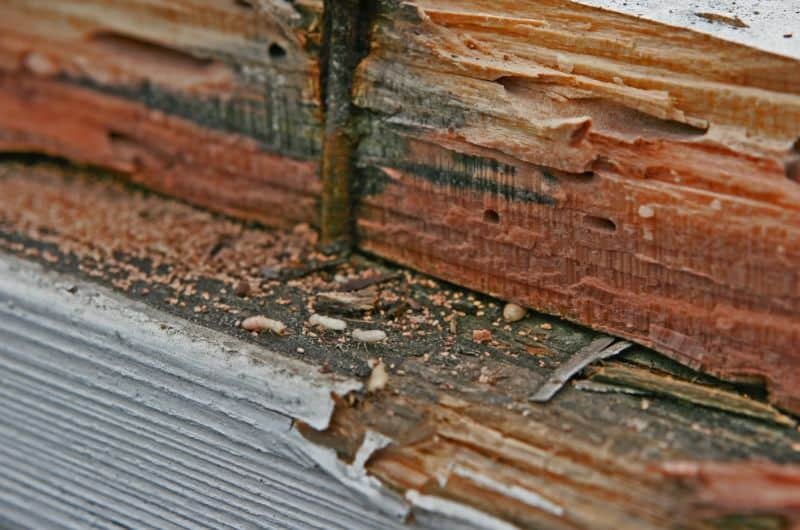
Early detection of termites can significantly reduce the extent of damage and the costs of repairs.
Keep an eye out for these signs:
- Physical Signs: Termite droppings (frass), mud tubes on exterior walls, discarded wings, and visible swarms of termites are tell-tale signs of an infestation.
- Structural Damage: This includes hollowed or damaged wood, blistering paint, and visible holes in wood structures. Termites consume wood from the inside out, often leaving a thin veneer of timber or paint.
Proactive Prevention: Securing Your Home
Preventing termites involves a combination of good practices and structural maintenance:
- Seal Cracks and Crevices: Regular inspections for cracks in the foundation, around utility lines, and other potential entry points are essential. Sealing these gaps can significantly reduce the likelihood of termites entering your home.
- Wood Storage and Maintenance: Keep firewood, lumber, and other wood debris away from your home’s foundation. Ensure that wood structures are properly maintained and treated, especially those in contact with the ground or exposed to moisture.
- Property Maintenance: Fix leaks promptly, ensure proper drainage around your home, and maintain gutters and downspouts to minimize moisture accumulation that can attract termites.
Comprehensive Termite Control Services
Tabor Pest Control offers a range of professional services to detect, prevent, and treat termite infestations:
- Inspections: Our team conducts thorough inspections to identify termite activity and assess risk areas in and around your home.
- Customized Treatment Plans: We develop treatment plans tailored to your home’s specific needs, utilizing the most effective methods such as bait stations, soil treatments, and direct wood treatments.
Advanced Wood Treatment Options
Choosing termite-resistant construction materials can greatly reduce the risk of infestation. Here are some advanced wood treatment options to consider.
- Pressure-Treated Wood: Wood treated with preservatives to deter termites is ideal for structures in contact with the ground or exposed to the elements.
- Composite Wood: A durable, low-maintenance material that is less appealing to termites, perfect for outdoor decking and fences.
- Yellow Cedar and Other Resistant Materials: Some woods, like yellow cedar, are naturally resistant to termites. Using such materials in construction can provide an added layer of protection.
Tabor’s Commitment to Your Home’s Safety

At Tabor Pest Control, we understand the stress and damage termites can cause. We are committed to providing effective, long-term solutions to protect your home.
Our team is equipped with the knowledge, tools, and experience to ensure your home remains safe and termite-free.
- Effective Termite Prevention: Regular inspections, proper maintenance, and using the right construction materials are key.
- Early Signs of Infestation: Include termite droppings, mud tubes, and structural wood damage.
- Termite-Resistant Construction Materials: Pressure-treated wood, composite materials, and naturally resistant woods like yellow cedar offer better protection against termites.
Contact Tabor Pest Control at 877-448-2267 or use our contact form for a comprehensive approach to termite control. Our experts are ready to protect your home against these wood-destroying pests.
FAQs
What are the best methods for protecting wood from termites?
There are several effective methods for protecting wood from termites. One option is to use pressure-treated wood, which has been treated with preservatives that make it resistant to decay, termites, and other wood-eating insects. Another option is to use termite-resistant wood like cedar, redwood, or juniper, which are less appetizing to termite colonies.
Is drywood termite treatment an effective option?
Drywood termite treatment can effectively protect wood from termite infestation and damage. Various treatment options exist for drywood termites, including whole-structure fumigation, spot treatments, and preventative treatments like surface sprays, borate wood treatments, and bait stations. The effectiveness of these treatments depends on factors such as the extent of the infestation, the type and condition of the wood, and the application method. It’s essential to consult with a pest control professional to determine the most appropriate and effective treatment for your particular situation.
What are the advantages of using borate wood treatment?
Borate wood treatment offers several advantages. It is a termite, insecticide, and fungicide solution that can be applied to raw wood, providing crucial protection from termites and other pests. Additionally, borate wood treatments are typically low in toxicity and can be safely used in residential and commercial applications with proper precautions and as part of integrated pest management strategies.
Tags: Termites
Posted in Prevention & Control | No Comments »
Commercial Termite Control: 5 Must-Know Tips for Commercial Termite Control
Posted on: October 25th, 2023 1 CommentTermites can be devastating to any business, causing extensive damage to your property and creating an unsafe work environment.
In order to prevent this and keep your business safe from these pests, it is crucial to understand a little bit about the insects themselves and how to get rid of termites from your commercial property.
Importance of Termite Control for Businesses
Repair Costs
The most direct impact of termite infestations on unlucky businesses is the cost of repairs. Termites can be highly destructive and can cause extensive structural damage.
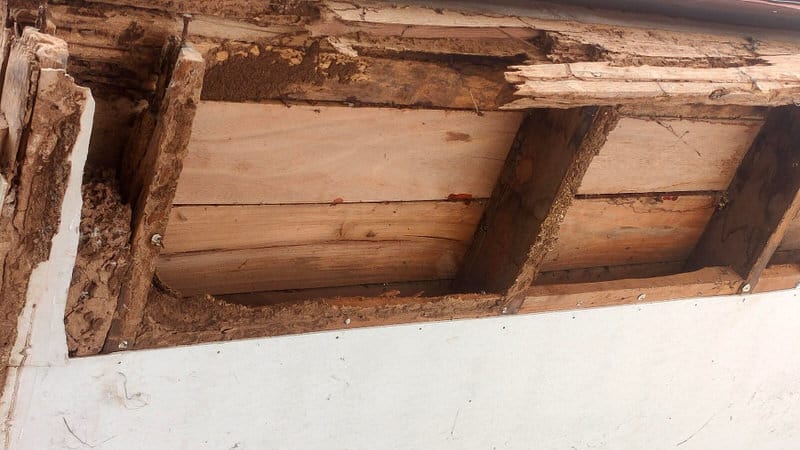
Wood is a primary food source for termites. So, the longer they are present in a building, the more damage they will cause.
Business Closures
Termites are also known to cause significant indirect problems, like closures. Damaged property may no longer be fit for business operations and may need to be closed during repairs.
This can negatively affect both revenue and reputation if not quickly resolved.
Decreasing Property Values
A termite infestation can also discourage future buyers from investing in a property because of concern for potential lasting damage.
How to Prevent an Infestation
The best way to avoid termite problems is never to allow them onto your property in the first place.
Here are some easy steps to deter these pests:
- Do not allow excess moisture or sitting water to remain in the building
- Minimize wood-to-ground contact by putting your building on a slab that is above ground level
- Ensure proper ventilation and seal all cracks and crevices
- Store all wooden materials, organic waste, and untreated wood away from the building
Signs of an Infestation at Your Workplace
Early detection is crucial to deal with a termite infestation before it gets out of control. Luckily, there are several signs that you can look for.
1. Mud tubes
Termites build these tubes using soil, wood, and other debris to create a pathway from their colony to the food source.
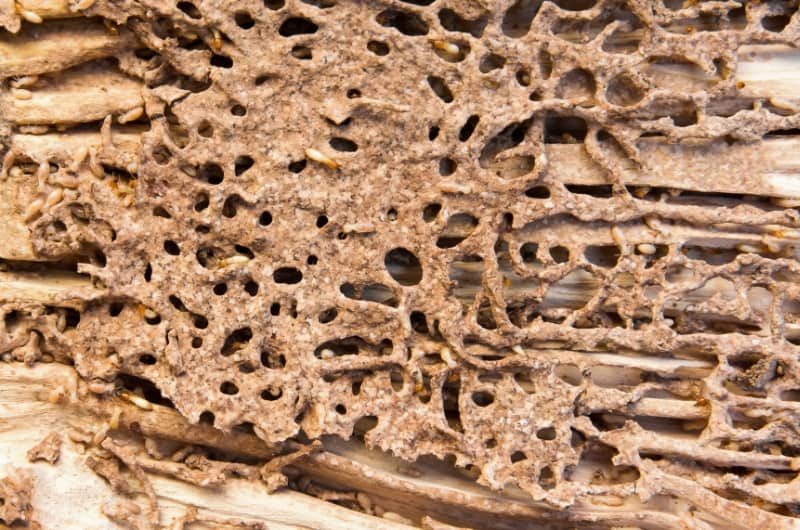
Look for them around the foundation of your building, as well as on walls and other wooden structures.
2. Discarded wings
Keep an eye out for piles of discarded wings near doors, windows, and other entry points. This is often one of the first signs that termites have settled into your property.
3. Wood damage
Termites feed on wood, so check for any signs of damage in vulnerable areas like wooden beams, furniture, and storage structures. Inspect these by probing them with a screwdriver – if the wood feels spongy or sounds hollow, it may be infested.
If you do observe any of these signs on your property, it is important to deal with the situation quickly.
Contact us at Tabor Pest Control to conduct a professional inspection and develop a treatment plan.
Commercial Termite Treatment Solutions
Every termite infestation can be a little different, so it’s important for us to work with you to develop a personalized treatment plan.
The process will, of course, start with a professional inspection. After that, there are many treatment methods that can be used to address a termite issue.
Here are some of the most common treatment methods:
1. Liquid treatments
Typically, it involves the use of a liquid termiticide, which is applied to the soil around the building’s foundation to create a protective barrier. Liquid treatments can be highly effective in preventing termite infestations and eliminating existing ones.
2. Bait systems
Involve placing bait stations around your property, which contain a termite-attractive substance infused with a slow-acting insecticide.
Termites feed on the bait and bring it back to their colony, eventually killing the entire infestation.
3. Direct chemical treatments
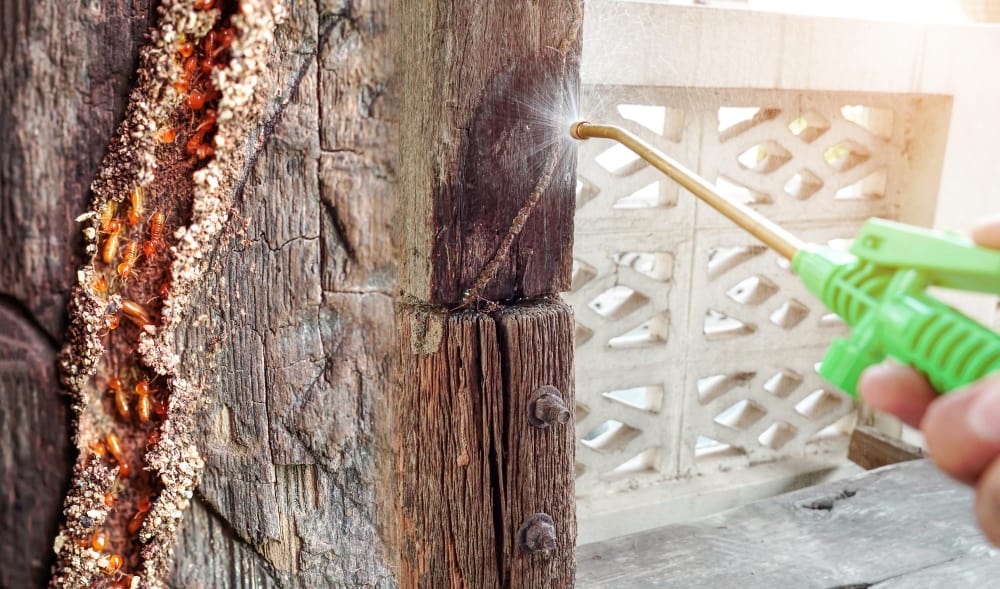
Involve injecting chemicals, such as foams or dusts, directly into termite-infested areas to eliminate the pests. These treatments can be particularly effective for localized infestations.
4. Physical barriers
Involve installing physical barriers, such as metal, mesh, or plastic, around the foundation or other vulnerable areas to prevent termites from reaching the structure. While not a standalone treatment, physical barriers can be a useful addition to other termite control methods.
5. Natural treatments
Examples of options can include introducing predator insects like nematodes, encouraging natural termite predators like birds or ants, or using botanical termiticides.
While natural treatments may not be as effective as chemical options, they can be a safe and eco-friendly choice. Choosing the right treatment approach will not only solve your current problem but will also prevent future issues.
You want a commercial pest control company that has experience working with similar situations and that is able to address your personal needs.
Tabor Pest Control has been providing high-quality commercial termite control services to the Southern Alabama area for over 60 years.
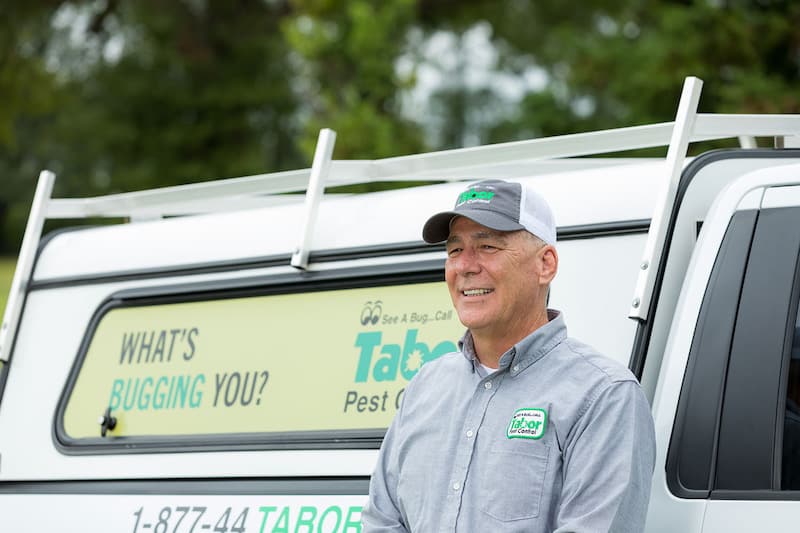
We pride ourselves on our customer service and our personalized approach to doing business.
FAQs
What are the most effective methods for commercial termite extermination?
There are several proven methods for commercial termite extermination. The most common methods include liquid barrier treatments, baiting systems, and fumigation.
Liquid barrier treatments involve applying a chemical solution to the soil surrounding your property, which prevents termites from accessing the building.
Baiting systems use strategically placed bait stations to attract and kill termites.
Fumigation is reserved for severe infestations and involves sealing off your property and filling it with a gas that kills termites.
Which chemicals are commonly used in professional termite treatment?
Professional termite treatment often involves the use of chemicals such as fipronil, imidacloprid, and chlorantraniliprole. These are insecticides specifically designed to target termites while having minimal impact on the environment and other creatures.
It’s crucial to follow the guidelines and safety protocols associated with these chemicals to ensure effective and responsible termite control.
What are the costs associated with commercial termite control services?
the cost of commercial termite control services can vary significantly depending on factors such as the size of your property, the extent of the infestation, and the treatment methods used.
Typically, businesses can expect to spend anywhere from a few hundred to several thousand dollars for termite control services.
How often should businesses have termite inspections and treatments?
The frequency of termite inspections and treatments depends on factors such as your property’s location, level of risk, and history of termite infestations.
As a general guideline, most businesses (like restaurants) should have a termite inspection at least once a year, with more frequent inspections recommended in high-risk areas or properties with a history of infestations.
Regular inspections and treatments help ensure early detection and management of termite problems, preventing costly damage and disruptions to your business.
What certifications or licenses are required for commercial pest control technicians?
In most regions, commercial pest control technicians should have specific certifications or licenses to legally provide termite control services.
These requirements may vary depending on local regulations. Generally, technicians must complete a combination of classroom education and on-the-job training and pass exams to become certified or licensed.
It’s essential to verify that the pest control company you choose employs qualified and trained technicians who meet the necessary requirements for your region.
Are the chemicals used in termite treatments safe for my staff and customers?
Termite control chemicals are generally safe when applied by trained professionals according to label instructions.
However, it’s crucial to inform your staff and customers about the treatment, take necessary precautions, and follow any safety guidelines provided by the pest control provider to minimize exposure risks.
What is the difference between termite control for new constructions vs. existing buildings?
Termite control for new constructions often involves pre-construction preventive measures, such as installing physical barriers or treating the soil.
For existing buildings, termite control focuses on inspections, identifying infestations, and implementing treatment options, such as baiting systems or soil treatments, to eliminate termites.
How long does a typical commercial termite treatment last?
The duration of termite treatment effectiveness can vary based on factors like the treatment method, type of termites, and environmental conditions.
Some treatments provide protection for several years, while others may require regular maintenance to remain effective. Your pest control provider can offer specific information based on your situation.
Can termite infestations affect the value of a commercial property?
Yes, termite infestations can potentially impact the value of a commercial property. If left unaddressed, termites can cause structural damage and require costly repairs.
Sellers are often required to disclose termite issues, which can affect negotiations and property values.
Regular termite inspections and proactive control measures can help protect property values.
References
- https://www.fdacs.gov/Business-Services/Pest-Control/Licensing-and-Certification
- https://www.epa.gov/safepestcontrol/termites-how-identify-and-control-them
- https://extension.umd.edu/resource/termites
- https://ipm.ucanr.edu/PMG/PESTNOTES/pn7440.html
- https://www.epa.gov/minimum-risk-pesticides
Tags: Commercial Pest Control, Termites
Posted in Prevention & Control | 1 Comment »
Termite Ground Treatment: The Homeowner’s Roadmap to a Pest-Free Sanctuary
Posted on: September 6th, 2023 1 CommentTermites are a very common and significant threat to the structural integrity of our homes. They are known to cause serious damage and can be difficult to get rid of.
In order to keep these pests out of our homes, we need to understand their behavior and be able to recognize the early signs of an infestation.
Termites are most comfortable in soil, and they feed on wood. So, any building with wood touching the ground is an ideal environment for them to live and build their colonies.
There are many options for termite treatment, but one of the most logical approaches involves products that are applied to the soil, since this is where they make their homes. Some of the most common are termiticides and baiting systems.
There are also many preventative measures that can be taken to avoid attracting them in the first place. These include using termite-resistant materials and creating barriers.
Regular inspections and maintenance from a professional pest control company will also go a long way in safeguarding your home from termites and other pests.
Understanding Termites
Termites live underground and eat wood, giving them the ability to burrow into your home and begin feeding on its foundation. They cost homeowners billions of dollars every year.
These pests are especially attracted to moist areas with an abundance of soil and organic material. So, inspect your property, taking note of spaces that may be potential termite attractants.
Also, inspect any wooden structure. Knock on them, and listen to hear if they sound hollow, indicating termite activity.
To identify termites that are already present nearby, look for mud tubes. These thin mud structures can be very small in size but are essentially the bridge the termites use to enter your house.
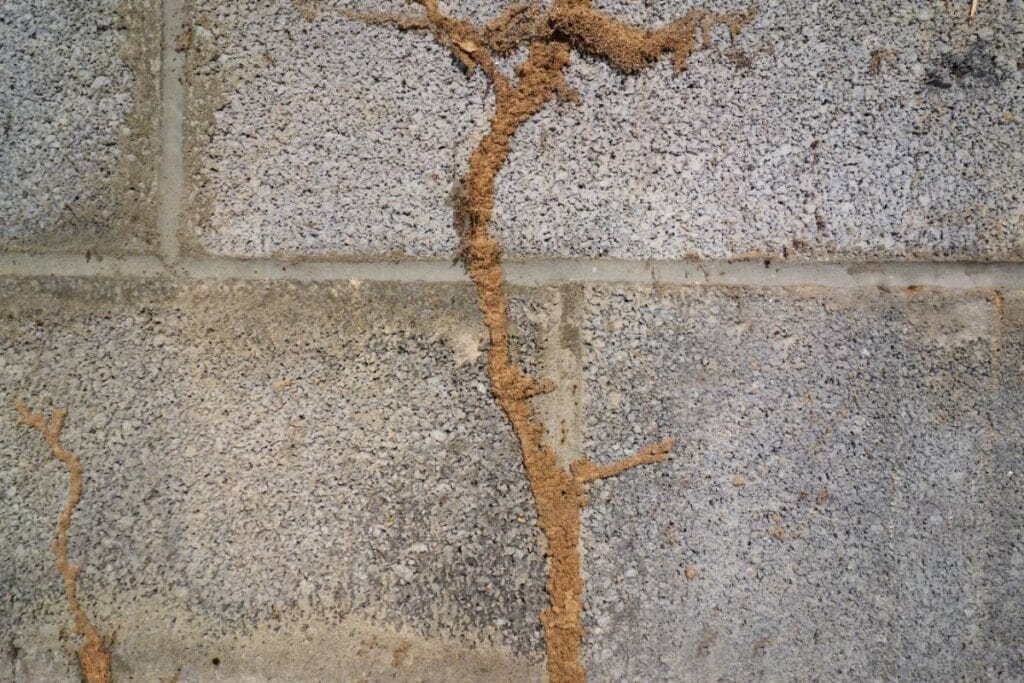
These tunnels provide the termites with a safe pathway directly to their food source.
Termite Inspections
Following the steps above will give you a good idea about whether or not there is a termite presence on your property. But in order to conduct a proper and thorough inspection, you will need a professional pest control service.
In addition to a visual inspection, these professionals will use specialized tools to detect termite activity that is not visible to the naked eye.
Moisture meters are used to find areas that are susceptible to termite infestations, and infrared cameras are used to spot heat signatures from the termite colonies.
Other common practices include termite monitors and bait stations. These devices are used to pinpoint the exact location of the termite in your home in order to address them and prevent a larger infestation.
Preventing an Infestation
In addition to regular inspection, there are several things you can do to avoid a termite problem in your home.
Consider installing a physical barrier to keep termites from reaching your home through the ground. These barriers can be made of metals, mesh, or crushed stone.
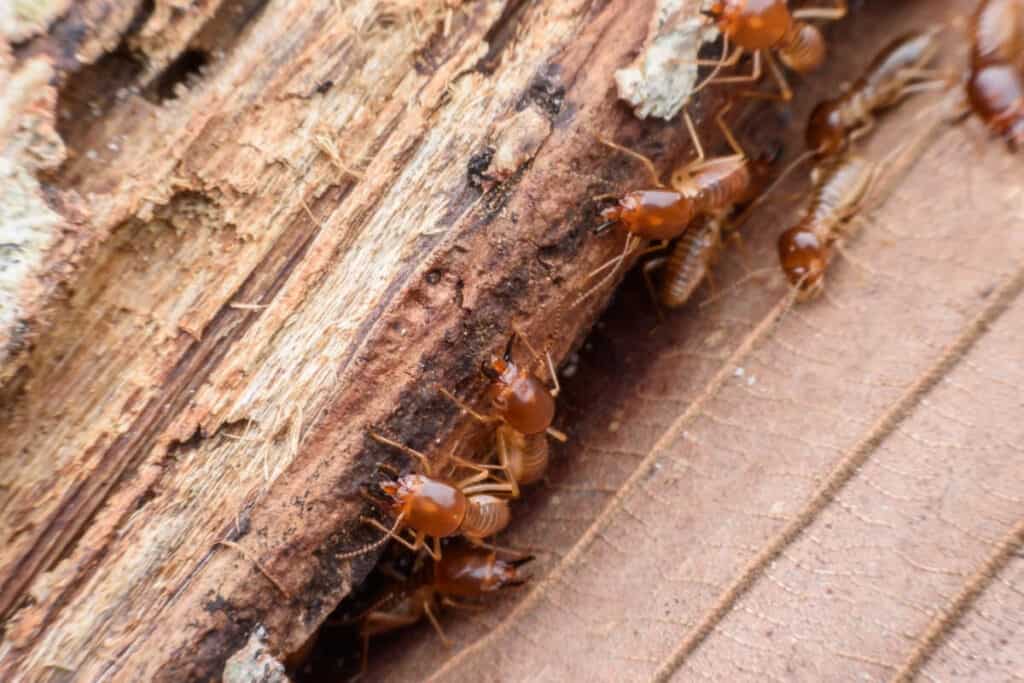
They should be installed around the foundation of your home and any underground piping, providing an impenetrable shield that forces termites to search for an alternative route.
Ventilation also plays a crucial role in termite prevention. Keep basements, attics, and crawl spaces well-ventilated and dry to discourage termite activity. Maintain proper air circulation and control humidity levels by installing vents, exhaust fans, or dehumidifiers in these areas.
If you notice any water leaks or moisture problems, fix them immediately to minimize the risk of termite infestation.
In addition to the above methods, you can follow these simple steps for further termite protection:
- Remove any wood debris, such as lumber, mulch, or firewood, from around your home’s foundation.
- Maintain at least a one-inch gap between the soil and wooden parts of your home’s structure.
- Inspect your property regularly for signs of termite infestation, such as mud tubes or damaged wood.
- Trim bushes and trees near your foundation to minimize access points for termites.
Chemical vs. Non-Chemical Termite Treatment
Termite treatment products can be broken down into chemical and non-chemical treatments. There are pros and cons for both, so consider your options to see what best fits your individual needs.
Chemical treatment involves applying liquid termiticide directly into the soil to address an existing termite issue.
Two of the most popular forms of termiticide are:
- Imidacloprid – This termiticide is typically applied to the soil surrounding your house or directly to the infested wood and is a very effective termite solution
- Fipronil – This product is very effective because of its ability to spread from one termite to another, meaning that it only needs to come into contact with one to wipe out the whole colony
Non-chemical treatment tends to be more preventative, including practices like:
- Regularly inspecting your home
- Properly maintaining your property (e.g., fixing leaks and removing wood debris)
- Creating physical barriers through construction materials or coatings
- Installing baiting systems to monitor and control termite populations
Non-chemical treatment is usually the safer option but may not have the immediate impact of the chemical treatment.
When in doubt regarding which kind of treatment is best for you, always consult a pest control professional.
Dealing with an Infestation
When dealing with a termite infestation in your home, it’s important to consider both the soil and wood aspects. Termites are known for causing costly damage, especially in wood structures.
To effectively control and prevent termite infestations, you need to employ a combination of treatment methods that target both soil and wood.
Soil Treatment
One of the most common ways to treat soil around your home for termites is to apply a liquid termiticide. This creates a barrier in the earth surrounding your home that the termites cannot cross.
Another option is using termite baits. Place them in strategic locations, moist areas with access to wood and soil, that are likely to be visited by foraging termites.
Wood Treatment
To keep termites away from the wood in your home, there are many effective preventative measures you can take, like using termite-resistant wood and ensuring proper spacing between wooden structures and the ground during construction.
To deal with a current termite issue, the most effective approach is chemical treatment. This will exterminate any termites present and deter future insect visitors.
Finding the right combination of soil and wood treatment is the key to ensuring that your home is termite-free.
Frequently Asked Questions
What are the most effective termite prevention products?
There are various termite prevention products available, but some of the most effective ones include termite bait systems and liquid termiticides.
Bait systems attract termites and slowly eliminate the colony. Liquid termiticides create a barrier around your property, preventing termites from entering.
How do I treat termites in walls?
Termites in walls can be treated using foam termiticides, dust insecticides, or fumigation. Many products can be applied directly to the affected area, killing termites on contact.
Fumigation involves tenting the entire structure and using a gas to exterminate the termites.
It’s essential to consult a professional to determine the right treatment for your situation.
Which is the best termite treatment company?
The best termite treatment company will vary based on factors such as location, experience, customer reviews, and services provided.
Do your research and consider local companies with positive reviews, credentials, and reasonable pricing.
What is the recommended termite soil treatment for new construction?
For new construction, soil treatment is usually done with a liquid termiticide, forming a barrier around the foundation.
Products like conventional soil-barrier treatments are applied before the foundation is poured to create a continuous barrier that prevents termites from entering the structure.
What are the common termite treatment chemicals?
Common termite treatment chemicals include fipronil, imidacloprid, and hexaflumuron. Fipronil and imidacloprid are non-repellent termiticides, which means they are undetectable by termites.
Termites unknowingly come into contact with the chemicals and transfer them to their colony, leading to its elimination. Hexaflumuron is a growth regulator found in some termite baits, which disrupts the termites’ growth and prevents them from molting.
How can I kill a termite colony in the ground?
Killing a termite colony in the ground requires targeted treatment. One effective method is using termite bait stations, which are placed in the ground around the property. Termites are attracted to the bait, consume it, and share it with their colony, eventually leading to the colony’s decline.
Another approach is using liquid termiticides to create a barrier around your property, which affects the termites if they attempt to cross it. Professional assistance is highly recommended for both methods.
References
https://content.ces.ncsu.edu/termites-biology-and-control
http://extension.msstate.edu/content/methods-termite-control
https://ipm.ucanr.edu/PMG/PESTNOTES/pn7415.html
https://www.epa.gov/safepestcontrol/termites-how-identify-and-control-them
Tags: Termites
Posted in Prevention & Control | 1 Comment »
Termite Troubles: How To Spot & Treat Termite Infestations
Posted on: March 14th, 2023 3 CommentsTermites cause one of the most troublesome pest infestations the U.S. faces each year, leading to an estimated $30 billion in damage, including crops and furniture.
Spring and summer are the swarming seasons for termites, but these little pests are clever and can stay hidden for years without significant notice.
The scary part is that once they infest your home, termites are quick to multiply and spread within a few days. So, taking precautions against termites is of utmost priority, which can be done by focusing on the tell-tale signs and using timely, effective treatment to deal with them.
Termite infestation
Termites inflict extensive home damage annually in the U.S., with populations in every state except Alaska.
On average, termite damage can cost American homeowners about $3,000 in repairs.
Alabama and Georgia are hot spots for termite infestation, so much so that Alabama ranks #1 in Termite Infestation Probability Zone, which is considered very heavy.
On the other hand, it’s estimated that 1 in 5 homes in Georgia has been infested by termites each swarming season.
With such a high infestation probability, knowing how to identify a termite infestation before it causes major damage to your property is vital.
How can you tell if you have termites in your home?
The thing with termites is that they can easily stay hidden. While they’re eating away at your home from the inside, you wouldn’t know anything is wrong until a few months or even years later.

The physical warning signs to recognize a termite infestation can include:
- Discolored or drooping drywall
- Peeling paint on the walls that looks like water damage
- Wood that sounds hollow upon knocking on it
- Small round holes in your furniture
- Wood that looks like it’s about to collapse or snaps on its own
- Squeaky wooden floorboards
- Tiles loosen from the added moisture that termites cause
- Piles of small transparent wings which termites often leave
- Mud tubes or small accumulations of wood shavings around or on your furniture
- Mounds of dry-wood termite pellets often resembling small piles of salt or pepper
Termite species in Georgia and Alabama
In Georgia, you can find three common types of termite species infesting your home including:
- Eastern Subterranean termite
- Formosan termite
- Drywood termite
The Eastern Subterranean termite is most commonly found infesting homes in Georgia, among the three species mentioned above.
The Formosan species is considered to be very aggressive, while the Drywood species is rarely found here as they mainly dwell around the Metro Atlanta area.
Both the Eastern Subterranean and Formosan are in-ground dwellers and enter your home through the flooring.
They are so tiny they can easily squeeze through gaps less than a one-sixteenth inch wide.
You will never be able to locate them on the ground surface as their survival depends on the constant need for water and moisture, thus locating them underground.
In Alabama, you can find Drywood and Subterranean termite species damaging homes. They generally swarm on a warm day after rainfall, so spring and summer are their swarming seasons.
How do I know it’s termites?
The termites that cause an infestation in your home are the ‘workers’ in the termite colony. Then there are ‘swarmers’ or ‘winged reproductive’ who are the colonists as they form new colonies.
You might be able to spot these as they find suitable locations for new colonies by going around.
Focusing on its physical attributes helps differentiate a termite from other insects, such as flying ants.
📌 Termites have a straight antenna, similar-sized, paired wings, and a thick but straight waist.
How can I prevent termite infestations?
Termites are tiny and so finding them or even looking for signs that they exist in your home can be tricky.
In fact, most people aren’t even aware they have a termite infestation until they see massive damage. Or the termite population becomes so significant that you see them flying or roaming around your house.
But there are ways you can prevent the infestation from happening again or follow a few steps to prevent termites from growing more.
- Fix any leaks in your home immediately.
- Keep your vents free, and if there’s any blockage, fix it immediately.
- If you have any trees or a yard around your house, maintain it properly, as overgrown trees around the home can allow infestation.
- If you have cracks around your home or between wooden floorboards, fill them up and close all the small gaps.
- If you have wooden piles around your house, dispose of them.
- Don’t allow any other kind of clutter around your home which might attract termites.
Most importantly, a regular inspection of your home is necessary. Because even if you try to look out for signs of termite infestation in your home, you might not come across their existence until they grow in abundance and lead to some damage to your property.
The only way to ensure they don’t form their colony is by getting a professional to do regular inspections in and around your home.
This is where Tabor Pest Control services will come in handy. Our experts have the proper knowledge and training to find termites and effectively treat them.
How can I treat a termite infestation?
1. Non-chemical treatment
When people hear that a termite infestation needs treatment, they automatically think that chemical treatment is what they’ll require. But that’s not true for every situation.
Sometimes, non-chemical treatments are way more effective. Finding the best treatment for your home will depend on multiple factors. But for now, let’s look at the non-chemical ways you can eliminate termites in your home.
- Using steel mesh and sands of particular sizes around the home has proved effective.
- Some biological control agents like nematodes and fungi are also promising in some cases.
- In high-alert-infested areas such as Alabama and Georgia, it’s most important to use physical barriers when constructing your house.
2. Chemical treatment
Using chemicals isn’t the only way to eliminate termites. It depends on how bad the infestation is in your home.
In the United States, before a company can sell or distribute any pesticide, EPA must review studies on the pesticide to determine that it will not pose unreasonable risks to human health or the environment.
Once determined, a particular pesticide will be registered for license and used per the instructions on the label.
Termiticides are specifically used to eliminate termite infestations in any home. Trained professionals at Tabor Pest Control ensure no damage to your property.
These treatments would include:
- Liquid soil-applied termiticides
- Termite baits
- Building materials with termiticides
- Wood treatments
3. Soil barrier treatment
This is the most common method when dealing with termites. The termiticides used for barrier treatments must be specifically labeled for this usage.
Along with that, there’s a need to follow proper instructions. Otherwise, it may cause damage to the property, including contamination of drinking water.
Our professionals at Tabor Pest Control are licensed in chemical treatment for effectively eliminating termites in your home.
4. Termite baits
Small amounts of bait products are used in edible forms around the infested areas to eliminate large colonies of termites. Once the bait affects a few termites, they share it with other termites. It spreads and helps reduce the number of termites.
Cellulose is used to make termite baits, a structural wood component. Combined with slow-acting insecticide, it sneaks up and works as an effective treatment.
This delayed action is essential so that many termites consume it before the action takes place. Otherwise, they might start avoiding the bait.
5. Fumigation
Fumigation is another technique for dealing with termites, but it has pros and cons. It might effectively kill the live colonies but doesn’t work as a preventive treatment against future colonies. So, you can say it’s pretty short-term.

This kind of method is particularly effective in dealing with Drywood termites. Since they have more potential entry points available as compared to Subterranean termites.
Dealing with a termite infestation
Summer and spring are swarming seasons for termites. They enter your home and start forming colonies which can go unnoticed for years until you see hefty damage to your property.
They can be a total nightmare since there could be multiple colonies. If you miss out on a few, it might cause infestation again.
Alabama and Georgia are hot spots for termites, so regular inspections are a must when it comes to termites.
While you might know multiple treatments and how to use them against termites, an effective treatment won’t be possible unless you’re a licensed professional.
You have to consider multiple factors before eliminating termites, including the species, their colonies, and the damage scale.
These factors could change the treatment our professionals at Tabor Pest Control would be using.
With our expert knowledge and the right equipment, we can effectively deal with termites at your home.
FAQs
Will termites go away on their own?
Termites will never go away on their own. They will jump from one piece of furniture to another in your home and end up eating everything from the inside out.
The only way to deal with them is to apply effective treatments to terminate their colonies before they can spread more.
What is the lifespan of a termite?
Termites will exist depending on their kind. A worker termite might survive for a year or two. A queen termite could go and live up to more than a decade in your home.
During that time, a queen termite can produce many termites.
What happens if you ignore termites?
If you see a termite infestation and think it could be smaller and ignore its existence, you could end up with thousands of dollars worth of damage to your home. A large colony of termites could exist in your home, and you won’t be aware of them.
If you see warning signs of their existence, immediately call us so we can find effective ways to deal with them before they spread more.
What attracts termites to a home?
Termites infest homes with leaky pipes, improper drainage, and poor airflow. These conditions allow the perfect moisture content to attract them and build colonies in your home.
Both Drywood and subterranean termites thrive in humid conditions.
Tags: Termites
Posted in Pest Identification | 3 Comments »
Common Pests In Southern Alabama & Georgia And How To Identify Them
Posted on: March 1st, 2023 3 CommentsIdentifying common pests can be difficult for property owners as they come with multiple species. Any incorrect identification of any insect, mammal, microbe, or organism could damage your property and health severely.
Incorrect pest identification could cost you your time, money, and energy.
That’s what we at Tabor Pest Control specialize in, where our experts help you identify the kind of pest that’s infesting your property and find an effective way to terminate it.
What’s the importance of identifying pests?
One of the common pests in the south (especially Georgia) is ticks, external parasites that feed on mammals’ blood. There are 15 species of ticks, and finding what is commonly found in properties can be challenging.
For example, the American Dog Tick is the most active spring, summer, and fall species. Wooded paths, parks, and farm pastures are their common dwelling areas.
Now, if you’re not aware of how to differentiate this particular species from the rest, you won’t be able to know to what extent they are dangerous, how they transfer, how they live, and how they interact with their environment.
Correct identification of pests helps find different strategies to manage, control, and terminate a species.
Common pests in Southern Alabama
Many pests dwell in Alabama, and in the peak pest season, it feels like all that’s around you are just pests.
Alabama’s moderate temperature is ideal for all kinds of bugs, insects, and pests to survive and make their colonies all year round.
Alabama is ranked 8th in states with the most bugs present. Here are some of the common pests you’ll find in Alabama:
1. Ants

Ants are the most common invaders in your house and are recognized by their different colors of red, black, or brown. The most common species found in southern Alabama include:
- Little black ants
- Argentine ants
- Fire ants
- Acrobat ants
Danger level
Ants might seem harmless, but they can be dangerous for spreading diseases. As they roam in the dirt, they can easily contaminate food and various surfaces in your home with bacteria and pathogens.
You must have heard fire ants being named the most dangerous as their bite is painful and hurts the most. They are aggressive, and once they sting, their venom is strong enough to produce an allergic reaction, sometimes even becoming life-threatening.
Where to find them?
Ants can invade your home through various sources, such as attacking your trash, pest house, gardens, compost, and any moist area.
Since these are small, they can quickly get through the tiniest cracks in your property and invade your home, trying to build their nest.
For fire ants, you have to look for open and vast sunny areas as they love to reside in such places, but the Argentine ants prefer the exact opposite, which is moist areas, so keep a lookout under sinks.
How to get rid of them?
We at Tabor Pest Control have experts who can identify which kinds of ants dwell in which secret spots of your house. Contact us to get a free quote.
2. Bed Bugs

These blood-feeding pests not only exist on your bed but can be found in various other places where they can hide for up to a year without feeding if the temperature is just right and build their colony.
Danger level
Of course, bed bugs are dangerous as they bite warm-blooded mammals and can leave you feeling extremely itchy all over or cause allergies.
Another added mess they make is ruining your sleep and making you feel uncomfortable and worried.
Where to find them
We know beds are a common place for bed bugs to exist, but other places include:
- Wooden furniture, walls, and floor
- Behind wall hangings, clocks, and pictures
- Behind wall voids
- Electrical outlets and electronics
- In your pending dirty laundry
Your family, you, and your pets could also come in contact with bed bugs and bring them over from various places such as relatives’ or friends’ homes, movie theatre seats, and any other public spaces.
You can identify their traces by looking for the skins they shed after sometimes blood stains on clothes and mattresses and feeling unexplainable itchiness whenever you sit somewhere or sleep.
How to get rid of them
We have experts who can identify if bed bugs are dwelling in which secret spots of your house. Contact us to get a free quote.
3. Cockroaches
These most popularly feared pests can fly as quickly as they can crawl. Cockroaches are the world’s most resilient and highly adaptable creature, and can survive and grow in any corner of your house if you don’t eliminate their species.

There are different kinds of cockroaches, including species that share the same roof as you:
- Smokey brown cockroach
- Oriental cockroach
- German cockroach
- Asian cockroach
Danger level
Cockroaches can be pretty dangerous because they spread diseases such as Salmonellosis, Dysentery, and E.coli.
Since they can travel through gutters and survive anywhere, they carry various pathogens and bacteria infecting your surroundings.
Their shed skin and excrement also cause an allergic reaction in children.
These pests are also good at destroying your property as they can eat through anything in your home, from wallpaper to rugs, so you need to eliminate them.
Where to find them
These pests can enter through any source, from delivery parcels to traveling through drains and sinks and popping up in your bathrooms in the middle of the night.
They mostly travel through the night and come up to find their food during the night, which is another reason you wouldn’t know they exist in your home.
They would mostly hide in drains or in cracks around your home. If you tend to leave food open along with kitchen cabinets, it’s like a free buffet for them and gets inside your pantry as well.
How to get rid of them
We have experts who can identify if cockroaches are dwelling in which secret spots of your house. Contact us to get a free quote.
4. Fleas and ticks
Fleas can jump easily from one spot to another and travel this way to invade your home, but ticks can’t do the same, and they crawl and then attach themselves to a food source.
But both have something in common: they feed on blood.
Warm and humid weather is essential for their survival so they can multiply quickly. While ticks prefer to feed on human blood, fleas don’t prefer humans.
But food is still food, so it might still count as food to them at the end of the day.
Danger level
Both fleas and ticks spread lots of diseases, including causing allergic reactions.
Flea saliva is a common source of an allergic reaction, and their bite may cause dermatitis making us feel itchy and uncomfortable.
They can also infect with parasitic tapeworms, so the danger level is pretty high.
Ticks, on the other hand, may be responsible for causing the following diseases:
- Lyme
- Rocky Mountain spotted fever
- Tularemia
- Babesiosis
- Ehrlichiosis
Where to find them
Most animals, such as pets, tend to bring ticks or fleas to our home if they’re overlooked and not given proper cleaning or bath, but any animal might also carry it, such as rats.
Wild animals should, therefore, never be played with as there’s a high possibility of them carrying both ticks and fleas.
When talking about fleas, you can find them surviving indoors as easily as outdoors, but ticks can’t breed indoors and can only survive outside.
Fleas tend to hide in dark shady areas such as bushes, thrown-away furniture, and any garbage pile. Ticks are likely found in tall grass, under leaf piles, wooded pathways, or ditches.
You can find fleas in bedding, around baseboards, inside rugs, carpets, and drapes when indoors.
You won’t even know about their eggs hidden away which only become active when they find the right temperature to hatch. Therefore, proper treatment and timely cleanliness of the house are required.
How to get rid of them
We have experts who can identify if ticks and fleas are dwelling in which secret spots of your house. Contact us to get a free quote.
5. Mosquitoes
One of the common pests around us is mosquitoes, the most annoying. They feed on our blood, and that’s how they multiply.

Despite us killing them easily with even our bare hands, a bite from the wrong mosquito species is enough to get us sick and even lose our life.
Danger level
Yes, their bites are itchy and painful. Still, they cause more harm than that by spreading numerous diseases through their bites, including the eastern equine encephalitis virus, the St. Louid encephalitis virus, and more.
They are quick to multiply and always travel in a herd, so you’ll find a bunch of them dwelling around your house or inside. They also carry parasitic heartworms, which are transmissible to dogs and cats.
Where to find them
Leftover water, which is unused, is a breeding ground for mosquitoes that are used to lay eggs by the females and hatch into mosquitoes. So still water is a major source, including even a small ditch near your home or a pond nearby.
The more it rains, the more water is going to accumulate and cause a breeding ground. In Alabama, the humid temperature is highly favorable for their growth.
How to get rid of them
We have experts who can identify if mosquitoes are dwelling and in which secret spots around your house. Contact us to get a free quote.
6. Moths
You can identify moths as scale-covered winged pests with threadlike or feathery antennae. They might appear in different bright color patterns on their wings as well.
Danger level
The larval stage of the moth, a caterpillar, can be dangerous as they’re big eaters causing a lot of damage to their surroundings, including your property.
Of course, your plants are in danger, and if they latch on to the indoor plants, you’ll quickly find them half-eaten. Their danger level differs depending on their species. While some damage fabrics, others damage your pantry.
Where to find them
You can see traces of moths in your clothes and pantry full of food items, so you’ll have to pay attention to such things. Of course, not keeping your house clean is a significant factor in attracting moths to your home.
They seek dark, quiet areas to survive. You might commonly find them in kitchens, bathrooms, closets, basements, and attics.
How to get rid of them
We have experts who can identify if moths are dwelling and in which secret spots around your house. Contact us to get a free quote.
7. Rodents

Rodents include rats and mice, which are pretty commonly found dwelling in residential areas and around them. They are quite the survivors eating away at anything with their front teeth, so dwelling on our property is easier for them.
Danger level
Rats and mice survive year-long but can be dangerous in various ways. Not only do they eat away at your furniture, destroying your property, but they also share your food with you and thus share their diseases with you.
Their excrement is enough to make things contaminated, and they spread bacteria, disease-causing pathogens, and parasites to make people ill.
It’s easier to identify their colony from the rotten smell and their chew marks.
Since they chew away at anything, this includes electrical wires and pipes, which can cause major damage to your property.
Where to find them
You can most commonly find them in gardens, trash cans, compost areas, pet foods, and outside areas.
They can gnaw away at anything, so it’s easier for them to exist in your hard if it’s not maintained or kept clean, which then becomes an easy gateway to your house.
They tend to remain in dark and quiet areas, and their movements are quick to give them away. Outside they might live near hollow trees or any such cavity inside your home.
How to get rid of them
We have experts who can identify if rodents are dwelling and in which secret spots around your house. Contact us to get a free quote.
8. Spiders
This eight-legged creature is despised and feared by many, which is why it’s essential to remove its existence from your home. Common species which invade properties in Alabama include:
- Black widow spiders
- Brown widow spiders
- Wolf spiders
- Jumping spiders
- Cellar spiders
Danger level
Some species of spiders, such as black widow and brown widow spiders, are dangerous, and their venom is strong enough to create health issues. But then there’re other common household species too.
It’s normal for them to create their web in any place where their food, such as other insects, is available in plenty.
Where to find them
Though they prefer to stay outside, they mostly move inside when the temperature drops as their prey moves indoors.
Cellar spiders can be found living in basements and humid areas of a property.
How to get rid of them
We at Tabor Pest Control have experts who can identify which spiders are dwelling and in which secret spots around your house.
9. Stinging insects
Stinging insects have their stinger at the end of the abdomen or tail to get their prey or defend themselves.
Now they have some benefits, as they eliminate insects like mosquitoes and flies, but they are also dangerous.
Some of the species existing in Alabama include:
- Wasps
- Yellowjackets
- Bald-faced hornets
- Mud daubers
Danger level
Some species can be aggressive in nature and possess venom, which, when injected, is enough to cause serious allergic reactions. Their stings are pretty painful and cause damage on different levels.
Species like mud daubers might sting if they feel threatened, but wasps, yellow jackets, and hornets are aggressive and may sting multiple times regardless of that too multiple times.
Where to find them
If you have other insects living on your property, it will be an attractive point for stinging insects to build their homes for food purposes.
Properties with huge backyards and vast gardens are prone to insects living there for water and food.
Yellow jackets can be found in recycling bins, trash cans, and outdoor eating areas.
You can find scorpions seeking humid environments to thrive, so inside the home, they can be found in basements, bathrooms, laundry areas, sinks, and tubs.
Wasps, mud daubers, and bald-faced hornets can be found living in chimneys and wall voids.
How to get rid of them
We have experts who can identify which stinging insects are dwelling and in which secret spots around your house. Contact us to get a free quote.
10. Termites
How can we forget the biggest culprit behind destroying properties that all property owners fear more than anything?
Termites cause billions of dollars worth of damage each year in the country with their colonies.

They stay easily hidden inside the wood, and sometimes all that’s remained is a hollow piece of furniture.
Drywood termites and subterranean termites are famously found in Alabama, while southeastern drywood termite is found primarily in southern Alabama.
- The eastern subterranean termite comes in from February to May during the day.
- Formosan termite comes at night during late spring.
- The dark southeastern subterranean termite comes in between March and June during the day.
- The southeastern drywood termite comes at night during the spring season.
Danger level
Termites are a big issue in states like Alabama. Their colony eats away at your property from the inside, causing lots of damage; therefore, their elimination is quite popular amongst property owners.
Where to find them
Alabama’s humid and warm weather allows subterranean species to survive as they get the perfect temperature.
They live near the moist soil forming at the dead tree trunks and can easily follow into your house through the garden and backyard through soil tubes.
They can be found inside any wood or furniture you own, on the floors, or even behind walls. The subterranean species seek water-damaged or decaying wood but also ordinary pieces of wood.
How to get rid of them
We have experts who can identify which termite species dwell and which secret spots around your house. Contact us to get a free quote.
Common Pests in Southern Georgia
1. Ticks
There are 15 species of ticks existing in Georgia. The three species you could come in contact with are:
Blacklegged tick
- Blacklegged tick commonly lives in wooded areas. It feeds on various hosts, such as deer and humans. They are reddish-brown in color and are 1/8 of an inch in length.
- Mostly active in spring and fall seasons.
- Responsible for causing Lyme disease.
Lone star tick
- Least likely to be in contact with.
- About 1/8 of an inch in length and brown in color. Females have a white spot in the middle of their back.
- Most active from April till July.
American dog tick
- Live in wooded paths, parks, and farm pastures.
- Prefer to use dogs and humans as hosts.
- Reddish-brown in color with white and yellow markings. The males are about 1/8 of an inch long, and the females are a bit large.
- It can cause Rocky Mountain spotted fever.
- Most active in spring, summer, and fall.
2. Termites
Eastern subterranean termites are the ones you should look out for, and they live in large colonies and cause huge property destruction.
- The workers are creamy white in color and also blind.
- Soldiers are the same size but have elongated yellow heads and large jaws to protect the nest.
- Kings and queens are dark brown or black. They are pretty large and have two translucent wings, which usually are broken off and can be seen as a sign of termite infestation.
3. Stink bugs
- They are shaped as triangular with a shield on their back.
- Emit a foul smell.
- Less than 1 inch long and approximately 17mm.
- Generally brown or tan but can have coppery or bluish metallic patches on their heads and pronotum.
- It can be encountered during the fall or early spring.
4. Odorous house ants
- Common ants that invade properties in Georgia.
- About 1/8 inch long in length.
- When crushed, they give a rotten coconut smell.
5. Rats
Rats in Georgia can carry diseases such as murine typhus, leptospirosis, and salmonellosis. Chewing away electrical wires, pipes, and property damage is an added disadvantage.
6. Norway rats
- They are larger but with short tails than their body.
- They are 10-12 inches in length with a brown/gray color.
- They are commonly found in urban areas around the basements area.
7. Roof rats
- They are slightly smaller, and their tails are longer than their bodies.
- They are black in color and have lighter underbelly.
- They prefer warm and moist climates and so are hidden in attics.
Tags: Ants, Bed bugs, Cockroaches, Fleas, Mosquitoes, Moths, Rodents, Spiders, Termites, Ticks
Posted in Pest Identification | 3 Comments »
